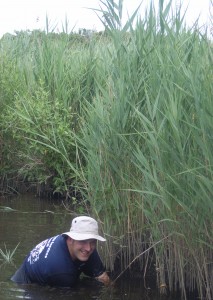by Kristen Minogue
Is it better to be a jack of all trades or a master of some? In the plant world, it’s possible to do both–and that could make a huge difference in deciding which plants dominate under climate change. This holds especially true for one: the invasive reed Phragmites australis. Its ability to alter its anatomy enables it to grow well in just about any environment, including one spiked with CO2 and nitrogen, SERC ecologists discovered in a study published Oct. 31.
Plants like this are called “jack-and-master” plants. Typically, the most competitive plants surpass their neighbors through one of two strategies. “Jack-of-all-trades” plants do moderately well under most scenarios. Their competitors will surpass them when conditions are good, but if the environment becomes stressful, the jack of all trades will grow better. “Master-of-some” plants do very well under only a few conditions, so if the environment shifts in their favor, they are certain to emerge victorious. But a few types—the jack-and-master plants—can use both tactics. And the invasive Phragmites is one of them.
In the Chesapeake, Phragmites comes in two varieties: an invasive strain from Europe and a more subdued North American strain. European Phragmites ranks among the most rampant plant invaders in the eastern U.S. It spreads rapidly and grows up to 15 feet tall, cutting off access to light and nutrients so nothing else can survive in its shadow. However, scientists did not know how it would fare as climate change accelerates.
For this experiment, ecologists Thomas Mozdzer and Patrick Megonigal looked at both types of Phragmites. They grew 52 samples (27 native and 25 invasive) in a SERC greenhouse and then exposed them to one of four treatments: elevated CO2, elevated nitrogen, elevated CO2 and nitrogen combined, and a control treatment. After two months they inspected each plant to see how it changed.
Far from being held back, invasive Phragmites gained roughly 40 percent more biomass under higher CO2. With CO2 and nitrogen combined, it shot up almost 300 percent.

Native and invasive Phragmites under different climate change treatments. Invasive Phragmites experienced a massive growth spurt under higher nitrogen (+N) and slight growth under elevated CO2 (eCO2). Native Phragmites had lackluster growth under most treatments, though it did well with higher nitrogen and higher CO2 combined (eCO2 + N).
The critical factor was flexibility, the hallmark of a jack-and-master plant. The invasive strain was able to change parts of its anatomy and physiology to fit its environment much more than the native strain. For example, when CO2 levels increased, the leaves of the invasive Phragmites thickened, allowing them to grow more with less water. When nitrogen levels in the soil rose, invasive Phragmites responded by growing less roots and more shoots. When nitrogen was limited, the invader changed its metabolism to maintain high growth. In all three cases, the native strain showed little or no variation whatsoever. However, the invader’s largest biomass gains came with higher nitrogen, something Mozdzer sees as a sign of hope.
“Not all is doom and gloom,” he said. “Our data also suggest its invasiveness under higher carbon dioxide could be lessened if anthropogenic nitrogen pollution were controlled, potentially limiting the invasion of this ‘super weed.’”
In other words, if less nitrogen from fertilizers and urban runoff goes enters the water, it could slow down the growth of Phragmites–even with extra carbon dioxide in the atmosphere. Not that Phragmites doesn’t have a few benefits (it’s extremely good at building up marsh peat and injecting oxygen into the soil, which in turn could help marshes survive sea level rise and emit less methane). But it has a darker side as well, as its expansionist tendencies edge native flora and fauna out of their homes.
More on Phragmites: “The Jekyll and Hyde of the Marsh” >>


